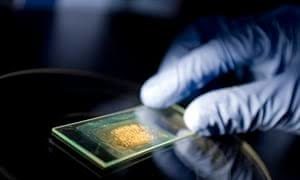NANOTECHNOLOGY ON THE CRIME SCENE

“The Diamond Age” a science fiction novel by American writer Neal Stephenson, published in 1995 depicts a near-future world, in which nanotechnology affects all facets of existence. Nanotechnology is already influencing many features of our life today including crime investigation and law enforcement.
 Introduction of nanotechnologies in forensic science and policing, has substantially transformed the processes of investigation by making it quicker, more scientific, more efficient, more precise, and simple to implement which is why this technology has gained tremendous significance. Our future has opportunities to promote a securer and crime-free environment through the use of nanotechnology.
Introduction of nanotechnologies in forensic science and policing, has substantially transformed the processes of investigation by making it quicker, more scientific, more efficient, more precise, and simple to implement which is why this technology has gained tremendous significance. Our future has opportunities to promote a securer and crime-free environment through the use of nanotechnology.
Nanotechnology is particularly proving precious in fingerprint analysis. The sensitivity of the fingerprint procedure has multiplied manifold because of the substitution of the existing materials such as carbon black, aluminium flake, and gentian violet with much smaller nanoparticles. The nanoparticles are making it easier to detect and lift fingerprints left even on complex surfaces such as an adhesive or textured material. Hidden fingerprints are likewise being revealed immediately and accurately using nanotechnology. The nanoparticles can make the fingerprints more prominent by binding to the grooves and ridges even on a deteriorated and faded print. Latest nanotechnology-based techniques is helping police officers analyse the evidences on the spot- bang on the scene of crime. Which is not only saving time of analysis but also curtailing the chances of error. Nowadays, in the forensic investigation process, different nanopowders are being used to affirm the latent fingerprints on varied surfaces. Fluorescent nanoparticles are upgrading the effect of the fingerprint by glowing in the dark and telling the patterns in a more obvious manner. To accomplish this, photoluminescent CdS semiconductor nanocrystals capped with dioctyl-succinate are being used to enhance the detection of fingerprints. Nanoparticles in fingerprint analysis are not only revealing the information in the fingerprint. In addition, it’s also revealing the lifestyle of the person who has left his fingerprint at the scene. The fingerprint besides the patterns also contains sweat and other metabolites of the person. The nanoparticles by binding to such body fluids and metabolites infused in the print, is able to disclose whether the owner of the fingerprint is a cocaine addict or an alcoholic but it’s also able to reveal his age, sex and the diseases he will doubtless suffer from.
 Nanotechnology is proving valuable to police even in the investigation of questioned documents. Let’s say, If we find a person hanging in a room with a written note in the body’s vicinity. And if the note has overlapping writings giving rise to the suspicion of it having the handwritings of two or different individuals. Under such circumstances, , nanotechnology is stepping in and coming to the rescue of the investigating officer through a nanotool called the “Atomic Force Microscope (AFM)”. This tool is helping the forensic scientists, study the surface of the paper at the nanoscale. It’s able to inform the pen, ink, pressure/intensity exerted while writing, ink crossing etc., helping the investigator determine whether the document is a forgery or written by one or more persons.
Nanotechnology is proving valuable to police even in the investigation of questioned documents. Let’s say, If we find a person hanging in a room with a written note in the body’s vicinity. And if the note has overlapping writings giving rise to the suspicion of it having the handwritings of two or different individuals. Under such circumstances, , nanotechnology is stepping in and coming to the rescue of the investigating officer through a nanotool called the “Atomic Force Microscope (AFM)”. This tool is helping the forensic scientists, study the surface of the paper at the nanoscale. It’s able to inform the pen, ink, pressure/intensity exerted while writing, ink crossing etc., helping the investigator determine whether the document is a forgery or written by one or more persons.
AFM is again aiding the investigating officer investigate body offences, by revealing the age of the blood sample. Blood with time becomes thicker and stiffer. AFM by measuring the viscosity or its dryness can disclose the date of the sample. AFM is also helping the detective in revealing the substances present in the urine. When the urine is mixed with gold nanoparticles and illuminated by a laser, a signal emitted is announcing the chemicals or materials such as drugs present in the urine. This, for instance, can help the detective know, if someone raped a person after being administered a drink spiked with a rape drug, even after several days following the episode.
The most promising application of nanotechnology appears to be in perfecting and enhancing DNA analysis. Nano-techniques have made extracting, amplifying, separating and sequencing DNA quicker, and handy. The next generation sequencing using nanotechnology is also helping the detective know the origin of DNA, whether the DNA lifted from the crime scene came from skin, blood, saliva, semen etc. besides unravelling the physical features of the owner of the DNA such as age, sex, and colour of hair, eye, skin etc. Nowadays, magnetic nanoparticles are being used to extract DNA from different biological sources like blood, hair, skin, semen, and saliva. It’s also now possible to analyse DNA sequence using AFM by putting the sample in carbon nanotubes.
Use of explosives and explosive based weapons has become rampant with terrorists and in terrorism incidents. Detection of trace amounts of an explosive is a difficult task because of many issues, such as low quantity of unexploded munitions, contaminated samples, and different sample collection procedure. A bomb blast, can scatter fragmented residues of explosive from the actual place of an explosion while unfragmented part of explosive could remain at the scene of the crime. During the crime scene investigation, investigators can use Nano-based technology to determine the unfragmented/trace amount of fragmented explosives from the crime scene. Nanotechnology is again proving effective in gunshot residue detection and evaluation.
Use of bar codes and trackers has become common these days. Trackers can help track down items which go missing or are stolen. Nano trackers are also being used to prevent prisoners from jail breaking and to monitor the prisoners after their release. Prisoners injected with nano trackers become easily trackable.
Nanotechnology is also helping differentiate forged products from originals. With the use of nanofibers and nanodots, police can prevent and detect counterfeiting crimes. Bio-Nanosensors are also finding application for detection of bioterror agents, drugs, explosives and identification of toxins.
Cranfield University developed plastic to recognise various narcotics at Silsoe in Britain eliminating costly and time-consuming drug testing labs. We could dip a gadget the size of a conventional pen in a simple saliva sample at the crime scene to confirm the absence or presence of drugs rapidly. This technology is also deployable, like alcohol breathalyser for drug testing.
Besides, a procedure perfected by Leicester University can serve in solving gun crimes. When an individual leaves a fingerprint on a bullet casing, the chemicals in print corrode the surface of the metal. It is now feasible to picture the etched fingerprints with a nanoscale developer even if someone cleans the gun casing, or washes it. Such a thing, would not have been conceivable a few years ago.
We have been deliberating how invaluable Nanotech is for forensics, but Ian MacDonald in his book “Brasyl” which is set in the Sao Paulo of 2032, presents a weird illustration of Nano-anti-forensics. In the book, a man uses a single shot disposable revolver to kill a woman. The man pulls the gun out, peels the strip on it, takes aim at the woman and fires the bullet at her. After firing at her, he flings the gun into the nearby gutter where the gun dissolves into a black liquid in no time and disappears into the sewer. Nanotechnology is the obvious technology which can construct such a weapon. The point is, had the gun not dissolved; ballistic experts would have established who the assassin was, by compiling evidence such as fingerprints, manufacture, markings available on the bullet etc. But now since the gun has self-destructed, even if there were witness to identify the man as the shooter, police would have no supplementary evidence to prove his guilt., hence there is a threat of nanotechnology becoming a criminal friendly anti-forensic technology.
It is thus imperative we analyse how criminal law should respond to criminal exploitation of nanotechnology. As an illustration, let’s consider that Dr Prakash, has an intention to kill his patient directly by injecting nanoparticles which will release poisons as instantly as it enters the bloodstream or indirectly by rupturing one or more arteries and causing internal bleeding that leads to his patient’s death. If the patient finally dies, it should be possible to convict Dr Prakash of murder in both the scenarios. It would be simple to convict him in the poisoning plot, but it would be difficult to establish the murder in the ruptured artery scenario as it wouldn’t be possible to establish the causation. It would be impossible for the prosecution to prove beyond a reasonable doubt that nanoparticles had caused the rupturing of the arteries in the second scenario.
Professor Katrina L. Sifferd, Assistant Professor of Philosophy, Elmhurst College, expects the possibility of nanotechnology being exploited to implant criminal mental states. For instance, let’s say Ramesh a regular straight male in an affair with Sujata ditches her. Sujata contemplates revenge on Ramesh, so she abducts him and uses nanotechnology to hyper-stimulate his hypothalamus and turns him into a gay paedophile. Ramesh now develops a yearning to have sex with young male kids. As a result, it is plausible that Ramesh could land up in prison and risk criminal prosecution under the POCSO Act for paedophilic behaviour.
Lastly, the degree to which Nano-crime evolves will depend on whether nanotechnology evolves from a lab technology to a democratic technology. If nanotechnology stays a lab technology, it will not have any potential for criminal exploitation, but its power for criminal exploitation will speed up once it mutates into a free technology like computer technology.
Scientists agree with the ancient wisdom that the world, in reality, is far different from what it appears to be. To know the ultimate truth, we need to penetrate deeper layers of our reality. Nanotechnology, just as in forensics and crime investigation, may have the latent capacity to help humankind investigate the nature of reality and lead us closer to our spiritual nature.
Source from: epaper/deccanchronicle/chennai/dt:01.04.2019
 Dr.K. Jayanth Murali is an IPS Officer belonging to 1991 batch. He is borne on Tamil Nadu cadre. He lives with his family in Chennai, India. He is currently serving the Government of Tamil Nadu as Additional Director General of Police, DVAC.
Dr.K. Jayanth Murali is an IPS Officer belonging to 1991 batch. He is borne on Tamil Nadu cadre. He lives with his family in Chennai, India. He is currently serving the Government of Tamil Nadu as Additional Director General of Police, DVAC.


